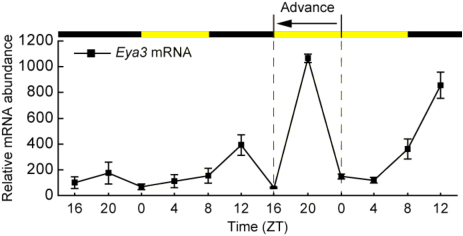| RIKEN Center for Developmental Biology (CDB) 2-2-3 Minatojima minamimachi, Chuo-ku, Kobe 650-0047, Japan |
December 10, 2010 – Many organisms, in both the plant and animal kingdoms, rely on length-of-day cues to detect seasonal change, and modulate their physiological activities to suit the time of year. This photoperiodism is involved in sexual maturation as well as hibernation and migratory cycles in animals, and has been implicated in seasonal affective disorder in humans. Previous research has shown that, in quail, an increase in day length induced the expression of the thyroid stimulating hormone, ß subunit (TSHß), which is a crucial regulator of the bird’s physiological function. But just how information about the length of daylight is transduced to TSHß has remained a mystery.
Now, Koh-hei Masumoto and colleagues in the Laboratory for Systems Biology (Hiroki R. Ueda, Project Leader) show in a unique mouse model that the transcription factor Eya3 not only induces TSHß expression but does so in response to light stimuli delivered early in the daily cycle. Their results, which appear in Current Biology, reveal an interesting mechanism behind the seasonal control of TSHß expression. Most of the mouse strains commonly used in research do not exhibit photoperiodism, but, it was recently reported that melatonin-proficient CBA/N mice show increased expression of TSHß in the pars tuberalis region of the brain in response to longer daylight, just as in the quail. Identification of this mouse model was an important first step, as it meant that the lab could bring the wealth of accumulated knowledge of mouse physiology and advanced genetic techniques, to bear on the problem. Masumoto started by conducting a whole-genome microarray analysis on pars tuberalis samples from mice that had been raised in either long-day (16 hours of light, 8 hours dark), or short-day (8h light, 16h dark) conditions. He found 246 genes (including TSHß) strongly expressed in the long-day samples, and 57 that were upregulated in the short-day mouse brain. Wanting to determine what would happen to the induction of TSHß when mice were shifted between short-day and long-day regimes, Masumoto found that while switching the lights off eight hours later (in a sense, delaying night) had no effect on TSHß, the opposite adjustment, speeding the arrival of morning’s light by eight hours, caused a rapid increase in the mRNA’s expression. But it still wasn’t clear what linked its expression to changes in the onset of day, so the team did a second round of DNA microarray testing, looking for genes that began to be expressed in advance of the switched-on TSHß. They found a total of 34, and homed in on a favorite candidate, Eya3, by virtue of, among other things, its known role as a transcriptional factor. Eya family factors work by forming complexes with Six family proteins, enabling them to regulate target genes. Looking back to the pars tuberalis from the brains of long-day mice, Masumoto et al. found that both Eya3 and Six1 were strongly expressed. Testing this association in an in vitro reporter assay, they confirmed that the co-expression of these two factors led to activation of the TSHß promoter. Further, this activation is enhanced by Tef and Hlf. Although Eya3’s expression under long-day conditions has been known previously from work in birds and sheep, this current work from the Ueda lab points both to its broad conservation and its mechanism of action. “In natural settings, of course, the progression toward a longer day is more gradual, so we think that the induction of TSHß by Eya3 should also play out over a longer time,” says Ueda. “But in this study we have shown that it is possible to induce Eya3 in a short period by manipulating exposure to light, which should be useful for future research into photoperiodism. We will also be very interested in working out how information about day length is relayed to this transcription factor, and why it is that morning light plays such a key role in determining photoperiod.” |
|||||
|
|||||
 |
| Copyright (C) CENTER FOR DEVELOPMENTAL BIOLOGY All rights reserved. |
